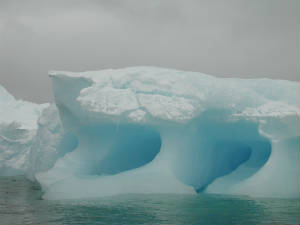|
December 21, 2004: Robertson Island
|
|
| Raising the Canadian flag at Mikkena Point |
In the morning we assembled
for an early briefing. Brad explained that we had reached a point of the Weddell Sea never before visited by passenger ships.
We were anchored off the coast of Robertson Island on the edge of the Larsen Ice Shelf. The staff was already going ashore
in zodiacs to establish a landing site in a cove that was normally shut in by ice. If all went well we would have an opportunity
to set foot on land where no human foot had ever trod.
The Canadians made the most
of the event. By the time we clambered ashore they had already planted a Canadian flag and christened the place “Point
Mikkena” in honor of the daughter of Brook Willis, the expedition’s second-in-command. Point Mikkena was a narrow beach beneath a high rocky ridge with a glacier looming into the sea at one
end. The whole area had only recently been covered with ice, for the beach was
littered with boulders, scree, and ice chunks like three-foot ice cubes. We walked
down the beach past an overhang festooned with icicles toward the point where the glacier was projecting into the bay. As
we walked, it actually calved a small iceberg. I heard the loud crack - but alas, I was looking at the path, not the glacier.
I quickly tired of clambering
over the ice and rocks in my oversize Wellington boots – the prescribed wear for zodiac landings. We returned to the ship for hot bouillon, and an hour reading the news in the Explorer Library (yes, we
did have daily news reports giving American, British, Australian, and Canadian versions of world events, all received by radio
and printed out nicely for us to read.) The library also offered a selection
of fascinating books on natural history and Antarctic exploration – even some novels for anyone with the time and inclination. While we browsed and then ate lunch, the ship sailed on for our second landing of
the day, another look at Robertson Island.

The second landing on Robertson
was at a point better known to scientists, who had visited here to study the marked shrinkage of the Larsen Ice Shelf. We
came in by zodiac through a field of ice floes and small icebergs. The island
itself was less interesting to me than the panorama of the bay, where ice debris floated like an extravagant carnival of ice
sculpture. With a little imagination there were ice birds, ice dogs, ice trolls, ice cities - many of them colored a gorgeous
aquamarine, sometimes with hints of deep lapis. The colors were caused by changes in the ice molecules during years of compression.
Now they had broken free and were floating in the bay like enormous gemstones. On
the way back to the ship we persuaded Mark, our zodiac captain to give us a detour through the ice fields to admire the color
and feel the cold brilliance of the ice. At one point we surprised three penguins lining up to dive from atop an iceberg. They stared down at us with annoyance before waddling off to try the other side.
We were still turned south,
pressing for the Antarctic Circle. At our evening briefing Brad urged us to spend as much time as possible on deck looking
for those emperor penguins. Then, just as we finished dinner, the announcement came that an emperor had actually been sighted
off the starboard bow. The captain slowed the ship and generously opened the
normally off-limits bow so we could have a closer look. We raced to the front of the ship, and on an iceberg off to the right
of us we saw two penguins. The ship had passed the birds, and they were already too far away to see well, much less photograph.
Some passengers started to back away with sighs of disappointment, but a crewmember motioned us to stay. To our amazement and gratitude, the ship was actually turning around for a second pass by the iceberg where
the penguins were standing.
There was only one emperor standing at attention on the ice, but he had
obliged us by bringing along an Adelie for size comparison. The emperor was at
least three times the size of the other penguin. The ship kept its position as
long as possible, but the emperor decided he had had enough of our gawking. He
moved away from us as fast as he could, using the interesting penguin technique called tobogganing – sliding on his
tummy while propelled by all four limbs, a motion not unlike swimming through the snow. The ship’s log reports that
in course of the night the crew sighted 26 emperor penguins – unfortunately at hours when I must have been sleeping.
|

